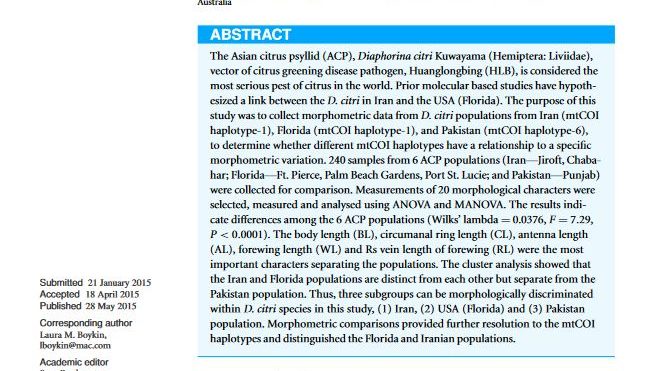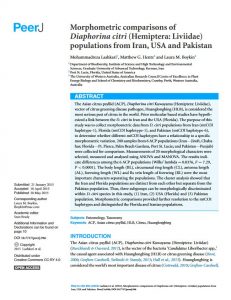The Asian citrus psyllid (ACP), Diaphorina citri Kuwayama (Hemiptera: Liviidae), vector of citrus greening disease pathogen, Huanglongbing (HLB), is considered the most serious pest of citrus in the world. Prior molecular based studies have hypothesized a link between the D. citri in Iran and the USA (Florida). The purpose of this study was to collect morphometric data from D. citri populations from Iran (mtCOI haplotype-1), Florida (mtCOI haplotype-1), and Pakistan (mtCOI haplotype-6), to determine whether different mtCOI haplotypes have a relationship to a specific morphometric variation. 240 samples from 6 ACP populations (Iran—Jiroft, Chabahar; Florida—Ft. Pierce, Palm Beach Gardens, Port St. Lucie; and Pakistan—Punjab) were collected for comparison. Measurements of 20 morphological characters were selected, measured and analysed using ANOVA and MANOVA. The results indicate differences among the 6 ACP populations (Wilks’ lambda = 0.0376, F = 7.29, P < 0.0001). The body length (BL), circumanal ring length (CL), antenna length (AL), forewing length (WL) and Rs vein length of forewing (RL) were the most important characters separating the populations. The cluster analysis showed that the Iran and Florida populations are distinct from each other but separate from the Pakistan population. Thus, three subgroups can be morphologically discriminated within D. citri species in this study, (1) Iran, (2) USA (Florida) and (3) Pakistan population. Morphometric comparisons provided further resolution to the mtCOI haplotypes and distinguished the Florida and Iranian populations.
Region: Iran, Pakistan, USA
Date published:
2015
Published by:
PeerJ
Type of resource:
Journal article
Resource topic:
Entomology
Project/Programme: Not specific
Pest/Disease: Asian citrus psyllid
Pages:
12
File type:
External link (1,160 KB)




